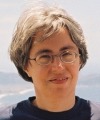Conference Chairs
Eugene W. Myers, Howard Hughes Medical Institute, Ashburn, VA, USA
Marie-France Sagot, INRIA Grenoble - Rhône-Alpes, Montbonnot-Saint Martin, France
Honorary Chair
Gunnar von Heijne, Stockholm University, Sweden
 Eugene W Myers,
Ph.D. is a group leader at the new Janelia Farm Research Campus of the Howard Hughes Medical Institute. Gene came to the JFRC from UC Berkeley in late 2005
where he was on the faculty of Computer Science. He was formerly Vice President of Informatics Research at Celera Genomics from 1998 to 2002 where he and his
team determined the sequences of the Drosophila, Human, and Mouse genomes using the whole genome shotgun technique that he advocated in 1996. Prior to that
Gene was on the faculty of the University of Arizona for 18 years and he received his Ph.D in Computer Science from the University of Colorado in 1981.
His specialty is the design and analysis of algorithms for problems in computational molecular biology and has recently begun to focus on building models
of the cell and cellular systems from imaging data. He is best known for the development of BLAST -- the most widely used tool in bioinformatics, and for
the paired-end whole genome shotgun sequencing protocol and the assembler he developed at Celera that put the data together. He has also written many seminal
papers on the theory of sequence comparison. He was awarded the Newcomb Cleveland Best Paper in Science award in 2001, the ACM Kanellakis Prize in 2002, and
was elected to the National Academy of Engineering in 2003. In 2004 he won the International Max-Planck Research Prize and in 2005 was selected as a distinguished
alumni at his alma-mater, the University of Colorado. In 2006 Gene was inducted into Leopoldina, the German National Academy and awarded an honorary doctorate at ETH, Zurich.
Eugene W Myers,
Ph.D. is a group leader at the new Janelia Farm Research Campus of the Howard Hughes Medical Institute. Gene came to the JFRC from UC Berkeley in late 2005
where he was on the faculty of Computer Science. He was formerly Vice President of Informatics Research at Celera Genomics from 1998 to 2002 where he and his
team determined the sequences of the Drosophila, Human, and Mouse genomes using the whole genome shotgun technique that he advocated in 1996. Prior to that
Gene was on the faculty of the University of Arizona for 18 years and he received his Ph.D in Computer Science from the University of Colorado in 1981.
His specialty is the design and analysis of algorithms for problems in computational molecular biology and has recently begun to focus on building models
of the cell and cellular systems from imaging data. He is best known for the development of BLAST -- the most widely used tool in bioinformatics, and for
the paired-end whole genome shotgun sequencing protocol and the assembler he developed at Celera that put the data together. He has also written many seminal
papers on the theory of sequence comparison. He was awarded the Newcomb Cleveland Best Paper in Science award in 2001, the ACM Kanellakis Prize in 2002, and
was elected to the National Academy of Engineering in 2003. In 2004 he won the International Max-Planck Research Prize and in 2005 was selected as a distinguished
alumni at his alma-mater, the University of Colorado. In 2006 Gene was inducted into Leopoldina, the German National Academy and awarded an honorary doctorate at ETH, Zurich.
 Marie-France Sagot,
Marie-France Sagot obtained a BSc in Computer Science in 1991 at the University of São Paulo,
Brazil, and a PhD and Habilitation in Theoretical Computer Science in 1996 and 2000 respectively at the University of Marne-la-Vallée, France. She was appointed Associate Researcher at the Pasteur Institute in Paris from 1997 to 2001, before joining the French National Institute of Research in
Computer Science and Control (INRIA) and the Laboratory of Biometry and Evolutionary Biology at the University of Lyon 1 and CNRS, France, where she
currently is Director of Research and head of the BAOBAB-BAMBOO teams. Her main research interests concern computational biology, algorithmics, and
combinatorics, and more specifically comparative genomics, chromosomal time and space dynamics, RNA structures, biological networks, and symbiosis.
She co-founded the French National Conference on Bioinformatics (JOBIM) and is member since its foundation of the Steering Committee of the European
Conference on Computational Biology (ECCB).
Marie-France Sagot,
Marie-France Sagot obtained a BSc in Computer Science in 1991 at the University of São Paulo,
Brazil, and a PhD and Habilitation in Theoretical Computer Science in 1996 and 2000 respectively at the University of Marne-la-Vallée, France. She was appointed Associate Researcher at the Pasteur Institute in Paris from 1997 to 2001, before joining the French National Institute of Research in
Computer Science and Control (INRIA) and the Laboratory of Biometry and Evolutionary Biology at the University of Lyon 1 and CNRS, France, where she
currently is Director of Research and head of the BAOBAB-BAMBOO teams. Her main research interests concern computational biology, algorithmics, and
combinatorics, and more specifically comparative genomics, chromosomal time and space dynamics, RNA structures, biological networks, and symbiosis.
She co-founded the French National Conference on Bioinformatics (JOBIM) and is member since its foundation of the Steering Committee of the European
Conference on Computational Biology (ECCB).
 Gunnar von Heijne worked mainly on problems related to protein sorting and membrane protein biogenesis and structure. The work includes both bioinformatics methods development (e.g. methods for prediction of signal peptides and other sorting signals as well as prediction of membrane protein topology) and experimental studies inE. coliand eukaryotic systems. The most important achievements include the discovery of the so-called (-1,-3)-rule (describes signal peptide cleavage sites) and the positive inside rule (describes membrane protein topology), the development of widely used prediction methods (e.g., TopPred, SignalP, TMHMM), and the first quantitative analysis of the energetics of membrane protein assembly in vivo.
Gunnar von Heijne worked mainly on problems related to protein sorting and membrane protein biogenesis and structure. The work includes both bioinformatics methods development (e.g. methods for prediction of signal peptides and other sorting signals as well as prediction of membrane protein topology) and experimental studies inE. coliand eukaryotic systems. The most important achievements include the discovery of the so-called (-1,-3)-rule (describes signal peptide cleavage sites) and the positive inside rule (describes membrane protein topology), the development of widely used prediction methods (e.g., TopPred, SignalP, TMHMM), and the first quantitative analysis of the energetics of membrane protein assembly in vivo.















